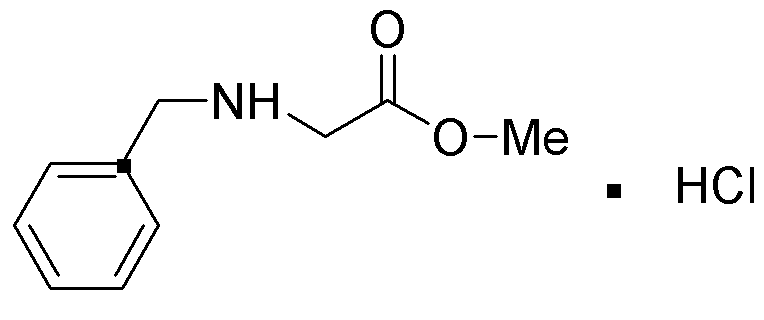Benzyl glycine methyl ester hydrochloride is widely utilized in research focused on:
- Pharmaceutical Development: This compound serves as a building block in the synthesis of various pharmaceuticals, particularly in the development of drugs targeting neurological disorders.
- Biochemical Research: It is used in studies investigating amino acid derivatives and their effects on biological systems, aiding researchers in understanding metabolic pathways.
- Peptide Synthesis: The compound plays a crucial role in the synthesis of peptides, which are essential for creating therapeutic agents and understanding protein functions.
- Cosmetic Formulations: Its properties make it suitable for use in cosmetic products, enhancing skin absorption and improving product efficacy.
- Analytical Chemistry: Benzyl glycine methyl ester hydrochloride is utilized as a standard in chromatographic techniques, helping in the accurate analysis of complex mixtures.
General Information
Properties
Safety and Regulations
Applications
Benzyl glycine methyl ester hydrochloride is widely utilized in research focused on:
- Pharmaceutical Development: This compound serves as a building block in the synthesis of various pharmaceuticals, particularly in the development of drugs targeting neurological disorders.
- Biochemical Research: It is used in studies investigating amino acid derivatives and their effects on biological systems, aiding researchers in understanding metabolic pathways.
- Peptide Synthesis: The compound plays a crucial role in the synthesis of peptides, which are essential for creating therapeutic agents and understanding protein functions.
- Cosmetic Formulations: Its properties make it suitable for use in cosmetic products, enhancing skin absorption and improving product efficacy.
- Analytical Chemistry: Benzyl glycine methyl ester hydrochloride is utilized as a standard in chromatographic techniques, helping in the accurate analysis of complex mixtures.
Documents
Safety Data Sheets (SDS)
The SDS provides comprehensive safety information on handling, storage, and disposal of the product.
Product Specification (PS)
The PS provides a comprehensive breakdown of the product’s properties, including chemical composition, physical state, purity, and storage requirements. It also details acceptable quality ranges and the product's intended applications.
Certificates of Analysis (COA)
Search for Certificates of Analysis (COA) by entering the products Lot Number. Lot and Batch Numbers can be found on a product’s label following the words ‘Lot’ or ‘Batch’.
*Catalog Number
*Lot Number
Certificates Of Origin (COO)
This COO confirms the country where the product was manufactured, and also details the materials and components used in it and whether it is derived from natural, synthetic, or other specific sources. This certificate may be required for customs, trade, and regulatory compliance.
*Catalog Number
*Lot Number
Safety Data Sheets (SDS)
The SDS provides comprehensive safety information on handling, storage, and disposal of the product.
DownloadProduct Specification (PS)
The PS provides a comprehensive breakdown of the product’s properties, including chemical composition, physical state, purity, and storage requirements. It also details acceptable quality ranges and the product's intended applications.
DownloadCertificates of Analysis (COA)
Search for Certificates of Analysis (COA) by entering the products Lot Number. Lot and Batch Numbers can be found on a product’s label following the words ‘Lot’ or ‘Batch’.
*Catalog Number
*Lot Number
Certificates Of Origin (COO)
This COO confirms the country where the product was manufactured, and also details the materials and components used in it and whether it is derived from natural, synthetic, or other specific sources. This certificate may be required for customs, trade, and regulatory compliance.

